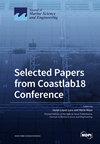水翼装置弦长和频率对赛道养殖中漂浮物排放特性的影响研究
IF 2.8
3区 地球科学
Q1 ENGINEERING, MARINE
引用次数: 0
摘要
为了研究振荡水翼装置的弦长和频率对漂浮颗粒物排放特性的影响,本研究以赛道养殖为例,基于计算流体动力学(CFD)系统地比较和分析了不同弦长和频率的水翼装置的流场特性以及赛道的排污性能。结果表明,在赛道养殖的颗粒物排放过程中,当水翼装置的弦长和运动频率分别为 0.1 W(W 为赛道宽度)和 1.0 Hz 时,水翼装置产生的反卡曼涡街受壁面影响较小,流场最均匀,颗粒物排放性能最好,最终漂浮颗粒物排放率高达 99.09%。调整水翼的弦长可以有效改善流场回流问题,提高流场的均匀性和流动性能。当弦长为 0.1 W 时,流场的均匀性最佳。当弦长为 0.2 W 时,流场的流动性能最佳。提高频率可增强流场的流动性能,运动频率平均提高 0.1 Hz,出口处的平均流速可提高 19.42%。基于此,我们建议在赛道养殖系统中使用弦长为 0.1 W、运动频率为 1.0 Hz 的水翼装置,以达到最佳的颗粒物排放性能,为在赛道养殖环境中使用水翼装置提高漂浮颗粒物处理效率提供理论依据和实践指导。本文章由计算机程序翻译,如有差异,请以英文原文为准。
Study on the Influence of Chord Length and Frequency of Hydrofoil Device on the Discharge Characteristics of Floating Matter in Raceway Aquaculture
To investigate the influence of the chord length and frequency of an oscillating hydrofoil device on the discharge characteristics of floating particulate matter, in this study, we take raceway aquaculture as an example and systematically compare and analyze the flow field characteristics of the hydrofoil device with different chord lengths and frequencies, as well as the sewage discharge performance of the raceway based on Computational Fluid Dynamics (CFD). The results indicate that in the particulate matter discharge process of raceway aquaculture, when the chord length and motion frequency of the hydrofoil device are 0.1 W (W is the width of the raceway) and 1.0 Hz, respectively, the anti-Karman vortex streets produced by the hydrofoil device are less affected by the wall, the flow field is the most uniform, the particulate matter discharge performance is the best, and the final floating particulate matter discharge rate reaches up to 99.09%. Adjusting the chord length of the hydrofoil can effectively ameliorate flow field reflux issues, enhancing the uniformity and flow performance of the flow field. When the chord length is 0.1 W, the uniformity of the flow field is optimal. When the chord length is 0.2 W, the flow performance of the flow field is superior. Increasing the frequency enhances the flow performance of the flow field, with an average increase of 0.1 Hz in motion frequency leading to a 19.42% improvement in the average velocity at the outlet. Based on this, we recommend the use of a hydrofoil device with a chord length of 0.1 W and a motion frequency of 1.0 Hz in the raceway aquaculture system to achieve optimal particulate matter discharge performance, providing a theoretical basis and practical guidance for using hydrofoil devices to improve the efficiency of floating particulate matter treatment in raceway aquaculture environments.
求助全文
通过发布文献求助,成功后即可免费获取论文全文。
去求助
来源期刊

Journal of Marine Science and Engineering
Engineering-Ocean Engineering
CiteScore
4.40
自引率
20.70%
发文量
1640
审稿时长
18.09 days
期刊介绍:
Journal of Marine Science and Engineering (JMSE; ISSN 2077-1312) is an international, peer-reviewed open access journal which provides an advanced forum for studies related to marine science and engineering. It publishes reviews, research papers and communications. Our aim is to encourage scientists to publish their experimental and theoretical results in as much detail as possible. There is no restriction on the length of the papers. The full experimental details must be provided so that the results can be reproduced. Electronic files and software regarding the full details of the calculation or experimental procedure, if unable to be published in a normal way, can be deposited as supplementary electronic material.
 求助内容:
求助内容: 应助结果提醒方式:
应助结果提醒方式:


